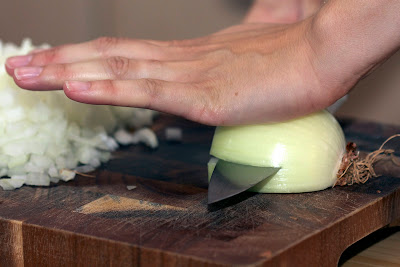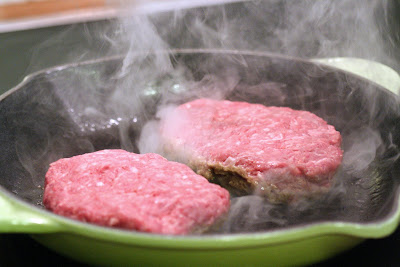Zwiebelkuchen and Neuerwein is currently on the menus of many restaurants around here. Zwiebelkuchen is basically a savory tart, kind of like a quiche without cheese and with onions. Lots of them. It is commonly paired with Neuerwein, or new wine, the semi-fermented wine of this year's grape harvest. It can vary widely in flavor and alcohol content: the sweeter it is, the less alcohol it has, and vice versa. Because I love this paring so much, I made it my mission to find a recipe and make it for myself.
I think I may have found a winner. I had to borrow from several places, combine a few recipes, and go to many restaurants to sample to see what I liked best (tough job, I know). But all that blood, sweat and tears (ha!) has paid off.
Because this recipe involves 1 1/2 lbs of onions I figured I would also include a little instructional guide to chopping them up. So first, I'll get started with the "how-to". It is best to use a fairly big knife for this task, I like using my 9" chef's knife. I've included pics, because sometimes it's a little hard to describe.
To start, cut the onion in half through the root and stem ends.
Working with one of the halves, place it flat side down and slice off the stem end (not the end with the little fuzzy brown stuff, that's the root). Leaving this end in place will help keep the onion together as you chop it.
Now, peel the papery outside off of the onion.
Next, with your knife parallel to the cutting board and starting near the bottom of the onion, slice through the onion almost up to the root end, but not all the way. Repeat 2 or 3 times depending on how small you would like your onion chopped.
The next step is to cut vertically through the onion. With your knife perpendicular to the cutting board and the tip of the knife pointing toward the root end of the onion, begin to slice vertically starting from one side and working across the onion to the other. You may lose a few pieces on either side, but that's ok.
Finally you'll make slices across the ones you've just made working from the end where the stem was to the root end. And there you go, you're done. The thing I haven't figured out yet is how to avoid crying while chopping. Any hints? Please let me know!
Now for the rest of the recipe...I should add, I made a shortbread crust for this. If you have a better recipe, by all means use it. If you don't have the time or inclination to make your own crust, I think a store-bought pie crust would also work.
Zwiebelkuchen (onion tart)
Crust adapted from Avoca Cafe cookbook
Filling adapted from Cooks Illustrated
Ingredients
For the crust:
8 oz plain flour (about 1 cup plus a heaping 3/4 cup)
5 oz butter (10 tbsp or 1 1/4 sticks), diced
1/2 tsp salt
2 egg yolks
For the filling:
2-4 slices bacon, depending how much bacon flavor you want.
vegetable oil, if needed
1 1/2 pounds onions (about 3 3"diameter onions), diced (yellow or white are fine, but not sweet onions)
1 sprig fresh thyme
3/4 teaspoon salt
2 large eggs
1/2 cup half-and-half
1/4 teaspoon ground black pepper
1 tsp caraway seeds, toasted
Directions
As a time-flow hint, you could start the crust, then while the crust is chilling or baking, or both, get started on the filling.
Make the crust.
Preheat oven to 350F/180C. Sift the flour into a bowl and rub in the butter until the mixture resembles fine breadcrumbs. Stir in the salt them mix to a dough with the egg yolks and a little cold water if necessary.
Cover with plastic wrap. Put into the fridge to chill for 20-30 minutes. After it has chilled, remove from the fridge and dump it into a pan with a removable bottom (you can use a regular pie pan, but it may be a little more difficult to get the Zwiebelkuchen out to serve). You don't really need to be neat about this. It's better if it isn't in one big blob. Using your hands, spread out the dough to an even thickness in the pan and around the edges. Place on cookie sheet and bake blind for 20 minutes (to bake blind, cover the pastry with parchment paper or foil and fill with dried beans or pie weights).
Remove paper/foil and beans, return to oven for 5-10 more minutes or until very lightly browned.Make the filling.
While crust is baking, cook bacon in 12-inch nonstick skillet over medium heat until browned and crisp, 8 to 10 minutes. Remove bacon slides from pan and let cool on a plate lined with a paper towel. If it looks like you have about 2 tablespoons of bacon fat in the pan, fine, if less, add vegetable oil to make up any difference.
Add onions, salt, and thyme to skillet. Cover and cook until onions release liquid and start to wilt, about 10 minutes. Reduce heat to low and continue to cook, covered, until onions are very soft, about 20 minutes, stirring once or twice (if after 15 minutes onions look wet, remove lid and continue to cook another 5 minutes). Remove pan from heat and let onions cool 5 minutes.
Whisk eggs, half-and-half, pepper and caraway seeds together in large bowl. Remove thyme sprig from onions and discard. Stir onions into egg mixture until just incorporated. Spread onion mixture over baked crust and crumble bacon evenly on top.
Increase oven to 375F. Return baking sheet with tart to oven and bake until center of tart feels firm to touch, 20 to 25 minutes. Cool on wire rack at least 10 minutes.
When ready to serve, remove tart pan ring (hint: place tart on a large can of tomatoes and the ring should just fall away with a little push), gently slide thin-bladed spatula between tart pan bottom and crust to loosen, then slide tart to serving plate. Cut into wedges and serve.
























































